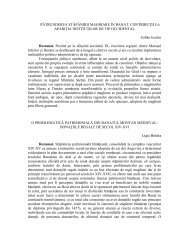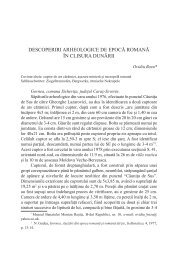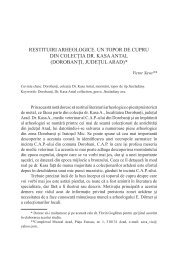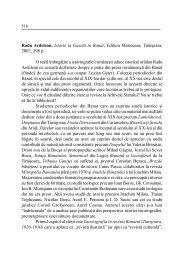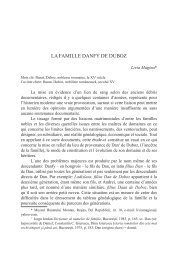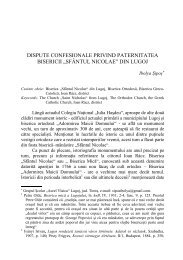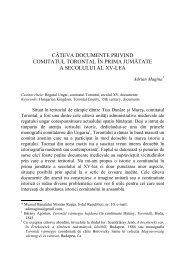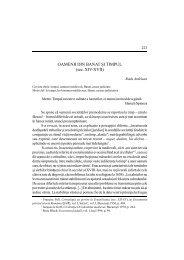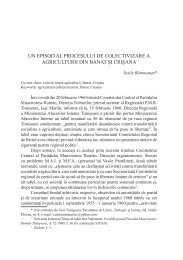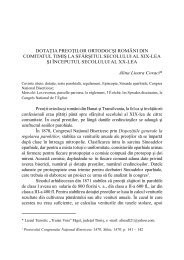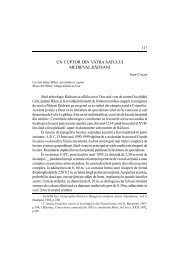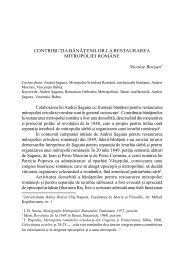jOHN HUNYADI BETwEEN BELGRADE AND CETATEA ... - Banatica
jOHN HUNYADI BETwEEN BELGRADE AND CETATEA ... - Banatica
jOHN HUNYADI BETwEEN BELGRADE AND CETATEA ... - Banatica
You also want an ePaper? Increase the reach of your titles
YUMPU automatically turns print PDFs into web optimized ePapers that Google loves.
54<br />
Peter moreover, probably at the same time, in October 1455, tried to win the<br />
confidence of Casimir IV (endeavor made easy by Mehmed II’s acceptance<br />
of Peter’s offer) and at least Hunyadi’s neutrality (who in early September,<br />
hesitated whether to attack in walachia or in Moldavia). Apparently, the ruler<br />
succeeded in both respects, for neither Polish nor Hungarian troops attacked<br />
him afterwards 65 .<br />
On june 29, 1456, by his oath of allegiance to Casimir IV, Peter Aron<br />
took on the obligation of recovering the lands taken from Moldavia (including<br />
Chilia) and accepted any potential royal ruling on Cetatea Albă, disputed<br />
between him and lady Marena, Elias I’ widow 66 . Three weeks earlier, the<br />
‘Moldavian Diet’ had approved Moldavia’s Ottoman tribute-paying vassality.<br />
However, both in june and july, during Mehmed II’s Belgrade campaign,<br />
Peter III Aron did not make any move against Chilia, held by john Hunyadi’s<br />
troops. Otherwise, as the Ottoman fleet attempted to enter the Danube<br />
Mounds 67 , Chilia would have probably fallen. Peter Aron probably awaited<br />
the outcome of the Hungarian-Ottoman conflict and of the walachian crisis.<br />
If john Hunyadi was defeated, he could always attack Chilia. If Mehmed II<br />
lost, then he could have (and probably would have if Hunyadi had not died)<br />
also taken control over Chilia, because of the walachian course of events in<br />
mid 1456.<br />
2. Two Paradoxes North-west of the Black Sea in the Mid and Late<br />
1450’<br />
with basically one great exception (in 1444), the Moldavian-Genoese<br />
disputes (1440’-1460’) usually irrupted at times when Moldavia took on a<br />
pro-Ottoman stand, while the otherwise prudent Genoese, favored the cross<br />
(the events of the mid 1450’ or of the early and late 1460’). Genoese politics<br />
1899, p. 118-120.<br />
65 See also Al. Simon, Notes on John Hunyadi’s Actions and Images, in Crisia, XXXVIII,<br />
2008.<br />
66 Documente moldoveneşti, II, no. 230, p. 779-787. For further analysis, see Şerban Papacostea,<br />
La Moldavie état tributaire de l‘empire ottoman au XV e siècle: le cadre international des<br />
rapports établis en 1455-1456, in RRH, XIII, 1974, 3, p. 445-461<br />
67 See Raguza, no. 342, p. 592; Al. Simon, Milanese Perspectives on the Hungarian Events of<br />
1456, in Miscellanea Historica et Archaeologica In Honorem Professoris Ionel Cândea, (ed.<br />
Valeriu Sârbu, Cristian Luca), Brăila, 2008, p. 249-260.



